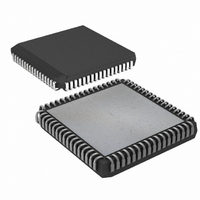DS87C550-QNL Maxim Integrated Products, DS87C550-QNL Datasheet - Page 23

DS87C550-QNL
Manufacturer Part Number
DS87C550-QNL
Description
IC MCU EPROM ADC/PWM HS 68-PLCC
Manufacturer
Maxim Integrated Products
Series
87Cr
Datasheet
1.DS87C550-QNL.pdf
(49 pages)
Specifications of DS87C550-QNL
Core Processor
8051
Core Size
8-Bit
Speed
33MHz
Connectivity
EBI/EMI, SIO, UART/USART
Peripherals
Power-Fail Reset, PWM, WDT
Number Of I /o
55
Program Memory Size
8KB (8K x 8)
Program Memory Type
OTP
Ram Size
1K x 8
Voltage - Supply (vcc/vdd)
4.5 V ~ 5.5 V
Data Converters
A/D 6x10b
Oscillator Type
External
Operating Temperature
-40°C ~ 85°C
Package / Case
68-LCC, 68-PLCC
Lead Free Status / RoHS Status
Contains lead / RoHS non-compliant
Eeprom Size
-
Available stocks
Company
Part Number
Manufacturer
Quantity
Price
Company:
Part Number:
DS87C550-QNL
Manufacturer:
Maxim Integrated
Quantity:
10 000
Part Number:
DS87C550-QNL
Manufacturer:
DALLAS
Quantity:
20 000
DS87C550 EPROM High-Speed Microcontroller with ADC and PWM
of the 10-bit conversion (i.e., bits 9-2). If OUTCF is a 1, then ADMSB contains A/D output bits 9-8 (right
justified). The upper 6 bits of the register are set to 0 in this case.
The value stored in the output registers is given by the following equation:
1024 x ((V
A
)/( A
- A
))
IN-
VREF-
VREF+
VREF-
This equation shows that the A/D conversion result is a 10-bit binary number that represents what
fraction of the available reference voltage the input signal is. As you can see with a reference voltage of
2.5 volts, the output has a resolution of 2.44 millivolts. This shows that the reference voltage must be
very well regulated to ensure satisfactory performance. It should be noted that the output of the A/D
conversion process will be “0000000000” for voltages from A
to (A
+1/2 LSB). In addition,
VREF-
VREF-
“1111111111” will be output for voltages from (A
- 3/2 LSB) to A
.
VREF+
VREF+
The DS87C550 offers a unique feature that allows the result of an A/D conversion to be compared with
two user-defined values stored in the WINHI and WINLO registers. The results of this comparison will
set or clear the WCM (ADCON 1.2) bit, and this bit can be used as a qualifier to the A/D interrupt. This
comparison is built into hardware so that this feature is performed without any burden on the software,
and A/D results that are not of particular interest to the application can be ignored. Special function
registers WINHI and WINLO are loaded by application software with 8-bit numbers that are compared
with the 8 MSBs of the A/D result. These user-defined numbers form a range of values, and the A/D
result is evaluated to be inside or outside of this range. When WCIO (ADCON.1) is 0, then WCM is set if
the A/D result is found to be inside the range. Otherwise WCM is cleared. When WCIO is a 1, then
WCM is set if the A/D result is found to be outside the range. Otherwise WCM is cleared. The state of the
WCM bit is expressed by the following equation:
WCM = WCIO Å (WINHI £ ADMSB) Å (WINLO £ ADMSB)
This equation precisely identifies the relationship between the window registers (WINHI and WINLO),
the MSB of the A/D conversion (ADMSB), and the WCIO and WCM bits. However by observation, it is
not particularly intuitive as to how this interaction works in a practical sense. If the user makes the
assumption that the value stored in WINHI is greater that the value stored in WINLO (this is normally but
not necessarily the case), then this equation can be simplified to the following two cases:
For WCIO = 0: WCM = (WINHI > ADMSB) AND (ADMSB ³ WINLO)
For WCIO = 1: WCM = (WINHI £ ADMSB) OR (ADMSB < WINLO)
It is clear that these two equations now express the cases where the A/D result is inside the comparison
window (WCIO = 0) and outside the comparison window (WCIO = 1). It is important to note the £ and
³ symbols and account for the specific values that are included in the comparison.
There is another SFR bit, WCQ, that further defines the action taken when the WCM is set. If WCQ is 0,
then an A/D interrupt will occur (if enabled) regardless of the comparison results. When WCQ is set to a
1, then an A/D interrupt will only occur if WCM is set (i.e., the A/D result comparison was true). This
feature allows software to respond only to conditions that meet the programmed range.
23 of 49














